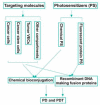Photodynamic Therapy: A Compendium of Latest Reviews
- PMID: 34503255
- PMCID: PMC8430498
- DOI: 10.3390/cancers13174447
Photodynamic Therapy: A Compendium of Latest Reviews
Abstract
Photodynamic therapy (PDT) is a promising therapy against cancer. Even though it has been investigated for more than 100 years, scientific publications have grown exponentially in the last two decades. For this reason, we present a brief compendium of reviews of the last two decades classified under different topics, namely, overviews, reviews about specific cancers, and meta-analyses of photosensitisers, PDT mechanisms, dosimetry, and light sources. The key issues and main conclusions are summarized, including ways and means to improve therapy and outcomes. Due to the broad scope of this work and it being the first time that a compendium of the latest reviews has been performed for PDT, it may be of interest to a wide audience.
Keywords: cancer; meta-analysis; overview; photodynamic therapy; review.
Conflict of interest statement
The authors declare no conflict of interest.
Figures







References
-
- Ferlay J., Ervik M., Lam F., Colombet M., Mery L., Piñeros M. Global Cancer Observatory: Cancer Today. International Agency for Research on Cancer; Lyon, France: 2018. [(accessed on 2 June 2021)]. Available online: https://gco.iarc.fr/today.
-
- Prime J. Les Accidentes Toxiques Par L’eosinate de Sodium. Jouve and Boyer; Paris, France: 1900.
-
- Tappeiner H., Jesionek A. Therapeutische Versuche Mit Fluoreszierenden Stoffen. Muench. Med. Wochenschr. 1903;1:2042–2044.
Publication types
Grants and funding
LinkOut - more resources
Full Text Sources

